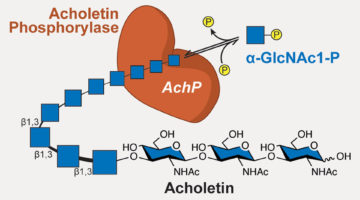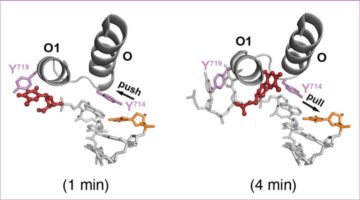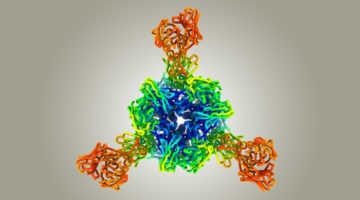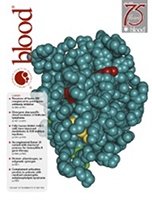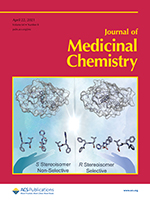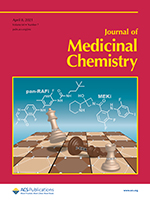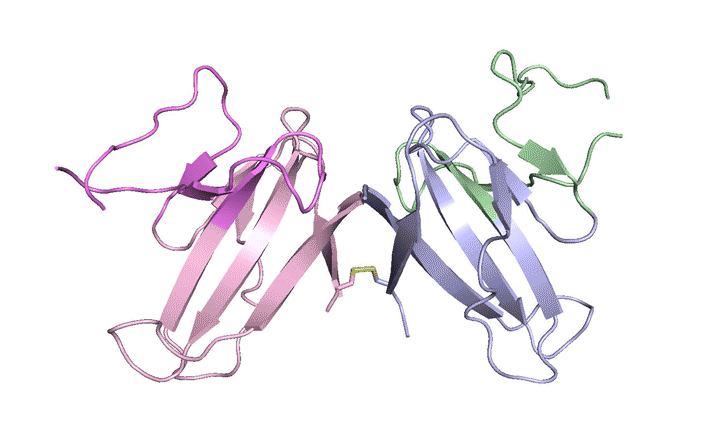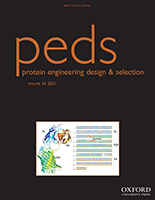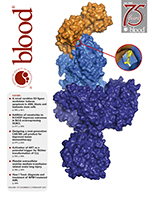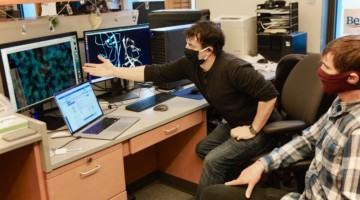Researchers discovered a bacterial enzyme that synthesizes a biopolymer whose repeating units are linked together in way that had not been previously observed. The new polymer is biodegradable and may be biocompatible, with potential for applications ranging from medical therapeutics to eco-friendly plastic alternatives. Read more »![]()
![]()
DNA Synthesis: Flip It and Reverse It
What if the current model for DNA synthesis were flipped on its head? Using time-resolved x-ray crystallography, researchers gained new insights into this essential biological process, revealing that two steps in the synthesis pathway are, in reality, reversed. Read more »
Researchers Set Sights on Another COVID-19 Target
Early in the COVID-19 pandemic, it was quickly established that the receptor binding domain (RBD) of the SARS-CoV-2 spike protein is a prime target for neutralizing antibodies. Now, scientists have found a second region of the spike protein that is targeted by dozens of antibodies, some of which exhibit ultrapotent neutralizing activity. Read more »
Structure of blood coagulation factor VIII in complex with an anti–C1 domain pathogenic antibody inhibitor
van der Waals sphere representation of the factor VIII C1 domain, highlighting surface‐exposed hemophilia A–associated mutations that cause impaired von Willebrand factor binding and overlap with a pathogenic anti‐C1 domain inhibitor epitope. Read more »
Structure-Based Design of Selective LONP1 Inhibitors for Probing In Vitro Biology
LONP1 is an AAA+ protease that maintains mitochondrial homeostasis by removing damaged or misfolded proteins. Elevated activity and expression promotes cancer cell proliferation and resistance to apoptosis-inducing reagents. Herein, we report the development of selective boronic acid-based LONP1 inhibitors using structure-based drug design as well as the first structures of human LONP1 bound to various inhibitors. Read more »
Targeting KRAS Mutant Cancers via Combination Treatment: Discovery of a 5-Fluoro-4-(3H)-quinazolinone Aryl Urea pan-RAF Kinase Inhibitor
The cover feature shows a chessboard (representative of KRAS mutant cells) and how the concerted action of the MEK inhibitor cobimetinib (rook) and the new selective pan-RAF inhibitor GNE-0749 (queen) force the opposing king (phospho-ERK, the downstream signaling node of RAF and MEK) into checkmate. Read more »
Mystery Protein Helps COVID–19 Avoid Immunity
Using the Advanced Light Source (ALS), researchers solved the structure of ORF8, a protein specific to SARS-CoV-2. Understanding the structure of ORF8 opens the door to therapy studies targeting SARS-CoV-2, the virus responsible for causing COVID-19. Read more »![]()
![]()
Construction, characterization and crystal structure of a fluorescent single-chain Fv chimera
In vitro display technologies based on phage and yeast have a successful history of selecting single-chain variable fragment (scFv) antibodies against various targets. However, single-chain antibodies are often unstable and poorly expressed. We explore the feasibility of converting scFv antibodies to an intrinsically fluorescent format by inserting a monomeric, stable fluorescent protein between the light- and heavy-chain variable regions. Read more »
CC-90009, a novel cereblon E3 ligase modulator, targets acute myeloid leukemia blasts and leukemia stem cells
A number of clinically validated drugs have been developed by repurposing the CUL4-DDB1-CRBN-RBX1 (CRL4CRBN) E3 ubiquitin ligase complex with molecular glue degraders to eliminate disease-driving proteins. Here, we present the identification of a first-in-class GSPT1-selective cereblon E3 ligase modulator, CC-90009, that targets acute myeloid leukemia blasts and leukemia stem cells. Read more »
The Odd Structure of ORF8: Scientists Map the Coronavirus Protein Linked to Immune Evasion and Disease Severity
Researchers determined the atomic structure of a coronavirus protein thought to help the pathogen evade and dampen response from human immune cells. Researchers determined the atomic structure of a coronavirus protein thought to help the pathogen evade and dampen response from human immune cells. Read more »
- « Previous Page
- 1
- 2
- 3
- 4
- …
- 9
- Next Page »
